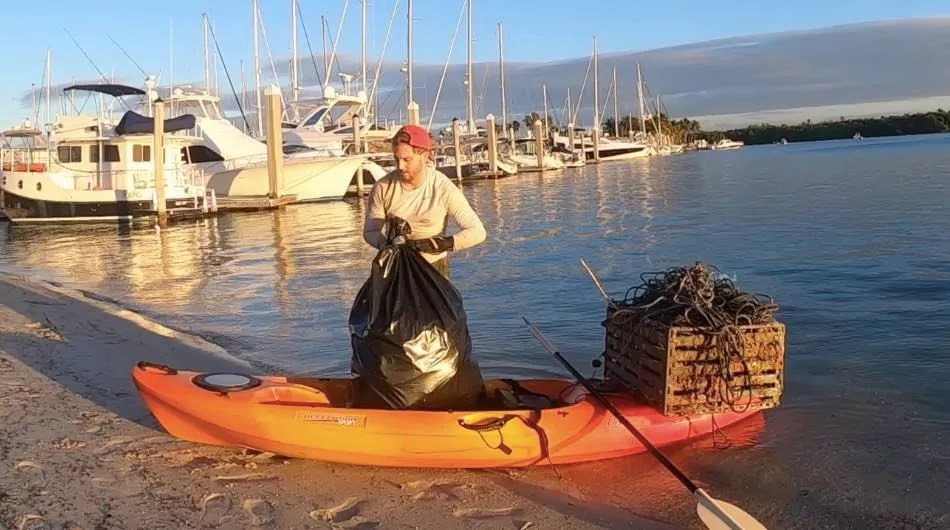
Photo courtesy of Andrew Otazo via Instagram

Audio By Carbonatix
Marathon runner Andrew Otazo spent his Christmas break wrangling garbage.
On December 23, the 33-year-old athlete and environmentalist rowed his kayak back and forth from a small, unnamed island in Biscayne Bay to the mainland, lugging huge black bags. The sacks weren’t full of gifts – they were filled with hundreds of pounds of plastic and other debris that had washed up on the island off of Crandon Park Marina.
It wasn’t the first time Otazo has targeted the area for a cleanup: On four separate trips to the island from June to December, he says, he picked up 1,670 pounds of trash, which he gathered from sunup to sundown, strapped onto his kayak, and then shuttled to the mainland for Miami-Dade County to pick up.
Although Otazo has done this kind of cleanup before in habitats such as Crandon Park, he says the pandemic made things a little different this year.
“I found lots of masks, gloves, and sometimes face shields,” Otazo tells New Times. “Literally everything you can imagine.”
Otazo says he found all manner of strange items washed up on the island this year, including a 50-gallon oil drum, a piece of a boat from Louisiana, and a large number of not-so-savory items.
“Needles, clothes, condoms, and underwear. An unnerving amount of underwear,” he reports.
While he normally goes out with groups of volunteers to do cleanups, Otazo says he decided to go it alone this year because of COVID-19. His parents are getting on in years and he doesn’t want risk to exposing them to the virus, so he chose to forgo a gathering, even if it was for a good cause.
But Otazo was determined to compete his one-man cleanup to protect the environment he grew up in and to raise awareness about how much of Miamians’ garbage ends up in Biscayne Bay and in critically important mangrove systems.
“I’ve been exploring these areas since I was 13. I’d go out into the mangroves and see so much trash, and when I found out how much of a keystone habitat mangroves are, I reached out to policymakers. But nothing would happen,” Otazo says.
According to the U.S. Fish and Wildlife Service, mangroves are home to at least 1,300 different animal species, including fish, birds, and mammals. They also serve as buffers to protect Miami’s shorelines from hurricanes and help to decontaminate polluted water.
On the various manmade islands in Biscayne Bay, the mangroves serve as rookeries, or breeding areas, for more than 30 species of indigenous birds such as brown pelicans, egrets, and herons. Otazo says while he was cleaning up garbage, he saw dozens of birds nesting, some of them already harmed by the pollution.
“I saw two pelicans that were both dead, their bellies full of trash. Because this is a rookery, baby chicks are being fed plastic,” Otazo says.
Much of the trash comes from everyday use; when people throw out their garbage on the street and it winds up in storm drains that pour out into the bay. The state and county have already pledged to spend millions of dollars to clean up Biscayne Bay, but the pollution is likely to continue building up and costing taxpayers millions more if our garbage habits remain the same. Otazo says that each day he’d go out to the island, there would be more trash than the last time, as the tide brings in debris daily.
Miami-Dade County recommends avoiding the use of single-use plastics, properly disposing of trash inside garbage bins, and using reusable bags whenever possible, among other tips to help keep the bay clean.
Otazo says that despite a sprained wrist and an aching body from lugging garbage, he’s going to continue doing his cleanups to bring more visibility to Miami’s sensitive habitats and, ideally, create policy change to reduce plastic pollution in South Florida.
“I want people to understand life cycle of plastic. If you drop any piece of trash into the ocean, ultraviolet rays break it into microplastics, then animals at bottom of the food chain ingest it, until it gets to tuna, marlin, and sharks, which we eat. We’re poisoning ourselves through the chain of plastic,” Otazo notes.